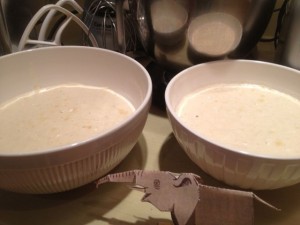Seasonally speaking, this is the time of year for enjoying panettone. You might be able to find a few panettone left at your local bakery, or grocery outlet – indeed I saw a few left at the store yesterday. They hadn’t been picked up before the holiday, so were sitting there, waiting for purchase, or a trip to the mark-down table.
Prices vary on store-bought, from under $10, to over $20 – so your mileage will vary there. Panettone can also be made in your home-kitchen, and in this blog post, I’ll show you how you can make a fine panettone at home.
This year, I made 4 panettone in the home-kitchen on Dec 20-21 – 3 went out as gifts, and 1 stayed home for us to enjoy on Christmas morning. I selected the recipe from Peter Reinhart’s book The Bread Baker’s Apprentice for this round. The formula results in 2 panettone loaves, and I usually like to do 2 batches at once to yield the 4-pack.

So, with sponge bubbling and fruit spiking, then go to bed, and return to the kitchen the next morning.
Make sure you’ve got all your ingredients ready the next morning, as you’ll need to plan for the various stages in the dough-making phase. This year, I got into the kitchen a little late, around 11:30 AM, but still had enough time in the day to complete.
I used 2 varieties of organic flour on-hand in the kitchen pantry for this dough, an organic unbleached white flour (14% protein) and a red-fife sifted wheat.
The formula calls for the wild-yeast to be spiked with commercial yeast, and I stuck with that plan – although didn’t actually proof the commercial yeast, so not sure if it had legs before I used it.
Once the dough has had a little time to proof (at least 20 mins), time arrives to mix in the spiked fruit, and some butter. The whisky did the job on this batch, creating quite a nice batch of fragrant, soaked fruit. Mmmmmm! This dough can be mixed by hand, or in a mixer. I’ve got the KitchenAid stand mixer here, so that really helps accelerate the bread-making process around here. However, this dough hits the capacity of the mixer, and needs to be carefully tended while making rounds in the bowl. This year I didn’t lose too much of it as it crawls up past the top of the dough hook into the axle housing of the mixer.
Once the almonds got mixed in, then the dough needs to sit out and rise at room temperature for a couple of hours, to increase in volume by approx. 1.5 times. During this time, go for a coffee, or run an errand or something. If needed, make sure pets will not devour the dough, and remind young children not to squish or slap the dough around, as it needs to rise undisturbed. This year, I went downtown to tackle some last-minute shopping while the dough was rising.
As you can see, the kitchen activity is quite spread out, so keep that in mind for planning purposes. This year, the loaves came out of the oven well before midnight, so that was nice – but if you start too late in the day, you can easily wind up spending a late night in the kitchen. You’re heading for an internal temperature of 185 degrees on these, so keep a close eye on that past the 60 minute mark. This year, I went just a touch long on the baking, so overshot 185 degrees – a valid excuse I have is that we got a new range this year, and I’m still getting used to baking with it ? c:-)
While I was out today, I called around to my usual suppliers in order to buy some more large-size panettone baking sleeves, but all advised that they were low on stock in the large size, and to try again next year. Bond Bond’s had some small-size panettone papers, so I bought some of those – thanks! I usually re-stock at this time of year while the local bakeries have their supplies at hand.
Anyhow, the panettone turned out nicely this year, and I’m almost ready to do 1 more round – will have to keep that wild yeast fed, and set aside a Friday night, and all-day Saturday to tackle this task…